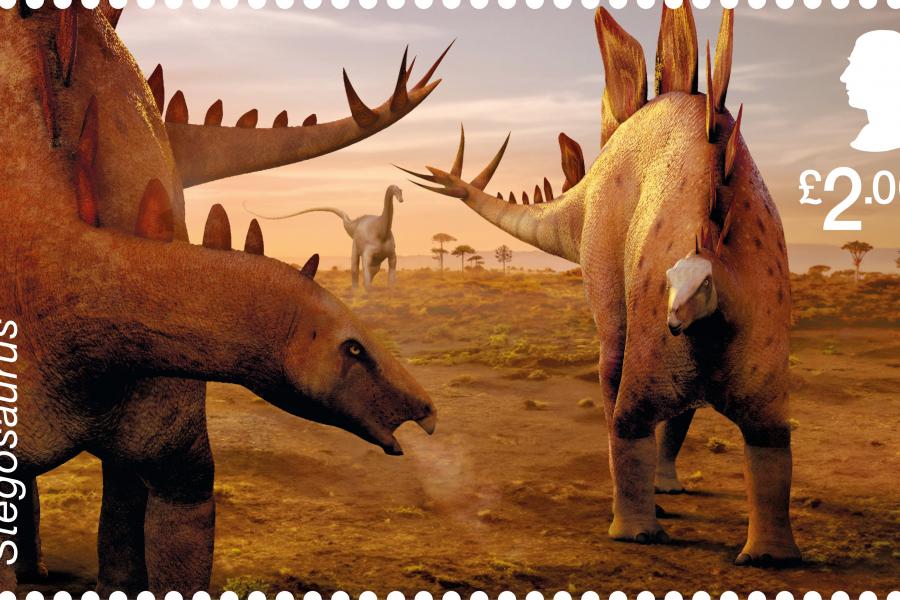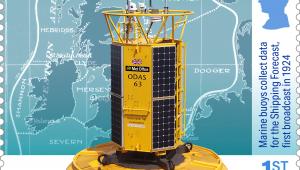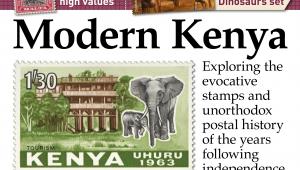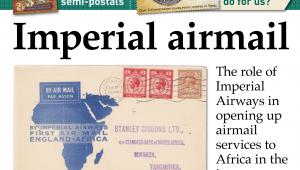Age of the Dinosaurs
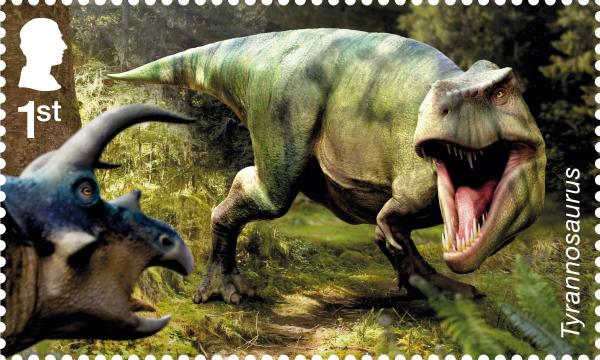
Eight stamps from counter sheets come in vertically se tenant pairs, each featuring dinosaurs from the same period. There are £2.00 pairs with scenes from the Early Jurassic and Late Jurassic periods, and 1st class pairs with scenes from the Early Cretaceous and Late Cretaceous periods.
Additionally, a self-adhesive miniature sheet of four stamps pays tribute to Mary Anning, one of the first professional fossil-hunters, who paved the way for modern palaeontology by unearthing ‘curios’ along what would become known as ‘the Jurassic coast’ in Dorset. She is portrayed on one 1st class design, and her major discoveries are presented on three others.
This year marks the 200th anniversary of the first ever scientific description of what would become known as a dinosaur, in 1824, although Royal Mail’s publicity surrounding the issue makes little of this.
Dinosaurs evolved during the Triassic period (252–201 million years ago), when all of Earth’s continents formed a single landmass called Pangaea and the climate was hot and dry.
After a mass extinction event towards the end of the Triassic, they thrived again and evolved into a wider variety of forms during the Jurassic period (201–145 million years ago), as Pangaea broke into two landmasses and increasing rainfall enabled plants and trees to flourish.
During the Cretaceous period (145–66 million years ago), the continents separated further, meaning that dinosaurs evolved in a more diverse way. Mammals began to flourish too, along with flowering plants and insects.
A mass extinction at the end of the period, believed to have been caused by an asteroid striking the Earth, saw all the dinosaurs die out, except the ancestors of birds.
All of the animals featured are named by genus, rather than precise species. Of those shown in the counter-sheet designs, coloborhynchus, iguanodon, megalosaurus and cryptoclidus fossils have been found in Britain.
Created in partnership with the Natural History Museum, with design direction by The Chase, the issue uses images by digital illustrator Joshua Dunlop for the counter sheet stamps. It was printed in litho by Cartor Security Printers.
The microtext captions in the border of the miniature sheet can be read with the aid of a magnifying glass.
1st class TYRANNOSAURUS
Tyrannosaurus was the apex predator of the Late Cretaceous period, with a more powerful bite than any other animal, and one of the largest land-dwelling carnivores ever, at up to 13m in length and 4m in hip height. It is illustrated squaring up to a triceratops.
1st class TRICERATOPS
Triceratops was a horned herbivore of the Late Cretaceous period, measuring up to 9m in length and weighing about five tonnes. Its impressive horns, hard beak and the bony frill over its neck offered some defence against large predators, and it is illustrated defending against a tyrannosaurus.
1st class COLOBORHYNCHUS
Coloborhynchus was a type of pterosaur, the group of flying reptiles which were the first vertebrates to achieve flight, and lived during the Early Cretaceous period. One of the largest known toothed pterosaurs, and possibly a fish-eater, it had a wingspan of up to 7m, and is illustrated flying over a fiery landscape.
1st class IGUANODON
Iguanodon was a large herbivore that lived during the Early Cretaceous period, up to 10m in length and probably consuming around 30kg of plants every day. Known for its distinctive thumb spike, it is illustrated in a herd, with coloborhynchus flying overhead.
£2.00 STEGOSAURUS
Stegosaurus was a large herbivore of the Late Jurassic period, weighing up to five tonnes, with bony armoured plates extending along its back and spikes on its tail. Although it is one of the most recognisable dinosaurs, complete fossils are rare. It is illustrated sharing open scrubland with diplodocus.
£2.00 DIPLODOCUS
Diplodocus, a herbivore of the Late Jurassic period, was one of the longest animals ever to have existed, reaching up to 27m in length and weighing around 20 tonnes. It may have used its long neck to reach the tops of trees, and its comb-like teeth to rake leaves into its mouth. It is illustrated towering over stegosaurus.
£2.00 MEGALOSAURUS
Megalosaurus was one of the largest predators of the Middle Jurassic period, growing up to 9m long and heavily built. It was the subject of the first ever scientific description of what would become known as a dinosaur, in 1824. Although a land-based animal, it is illustrated attacking a cryptoclidus in coastal waters.
£2.00 CRYPTOCLIDUS
Cryptoclidus was a type of plesiosaur, a marine reptile, of the Middle Jurassic period. Up to 4m long, its limbs were large paddles which helped it to manoeuvre in search of fish and squid. It is illustrated fending off a megalosaurus in shallow water.
MINIATURE SHEET
1st class MARY ANNING
At a time when Georgian collectors liked to visit seaside towns to acquire fossils, but palaeontology was barely recognised as a branch of science, Mary Anning (1799-1847) made a series of discoveries that contributed hugely to the understanding of prehistoric life. From the age of 12 she was finding fossils on the Dorset coast, near her home in Lyme Regis, and later set up a shop selling them.
1st class ICHTHYOSAUR
A complete fossilised juvenile skeleton of a marine reptile, Ichthyosaurus communis, 201–198 million years old, discovered by Anning around 1835.
1st class DAPEDIUM
A near-complete fossil of a fish, Dapedium politum, 199–190 million years old, discovered by Anning around 1829.
1st class PLESIOSAUR
A near-complete fossilised juvenile skeleton of a marine reptile, Plesiosaurus macrocephalus, 201–198 million years old, discovered by Anning in 1830.
ADDITIONAL PRODUCTS
The presentation pack, produced with the help of the Natural History Museum in London, has details of all the featured dinosaurs and Anning’s life and work.
In additional to the standard first day cover, there is a choice of coin covers with the Royal Mint’s new 50p coin depicting a tyrannosaurus rex.
A press sheet of 12 imperforate miniature sheets is available, as is the usual set of stamp cards.
PRICES
Set of 8 stamps £13.00
Miniature sheet £5.00
Presentation pack £18.90
First day cover (stamps) £16.25
First day cover (mini sheet) £6.65
Press sheet £60.00
Stamp cards £5.85
VERDICT
COMMEMORATIVE WORTH 3/5
Dinosaurs are an enduringly popular theme, in which the concept of an anniversary scarcely matters
QUALITY OF DESIGN 3/5
Digital design makes it possible to bring extinct creatures to life in a more realistic way than ever before
WOW FACTOR 3/5
The designs are vivid when enlarged, but rather less impactful at stamp size



